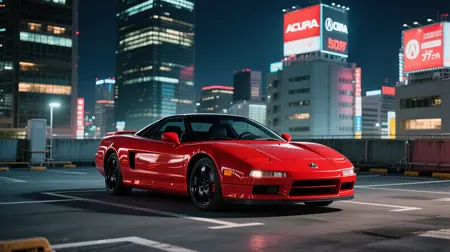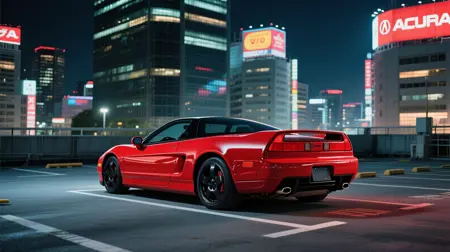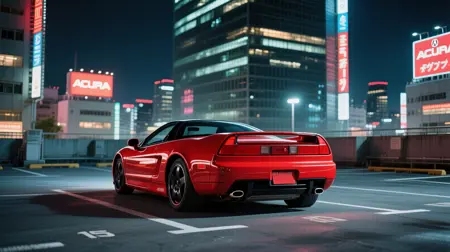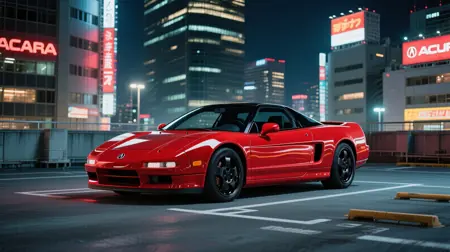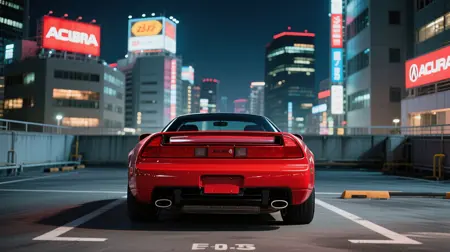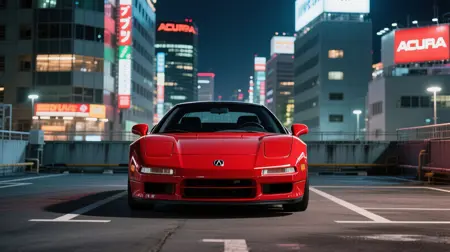Honda (Acura) NSX - 1991
Details
Download Files
About this version
Model description
The Polite Disruption: How the Honda NSX Changed Everything
In the late 1980s, the supercar was a European monarch. Names like Ferrari and Porsche commanded respect, but ownership came with accepted compromises: temperamental reliability, challenging ergonomics, and the constant threat of a tow truck. Into this world of beautiful but flawed machines stepped Honda, a company known for dependable sedans, with an audacious goal: to build a supercar that could beat a Ferrari 328 but remain as reliable as an Accord. The result was the 1991 NSX, a car that didn't just join the supercar club—it rewrote the rules.
The NSX was a symphony of groundbreaking engineering, born from a philosophy of balance over brute force. Its foundation was the world's first all-aluminum monocoque body in a mass-production car, a technique that saved nearly 200 kg (441 lbs) compared to steel. This lightweight, rigid chassis was crucial, allowing engineers to add features like air conditioning and power windows without sacrificing the agility of a true sports car.
The car's heart was a transversely-mounted 3.0-liter V6. In a pivotal moment late in development, Honda's president demanded the inclusion of the company's new VTEC technology, which had only been designed for four-cylinder engines. This "heart transplant while running a marathon" forced a chassis redesign but resulted in a masterpiece. Featuring the first-ever use of titanium connecting rods in a production car, the engine could safely scream to an 8,000 RPM redline, delivering 270 horsepower with a seamless surge of power.
While data drove the design, the car's soul was tuned by a legend. Honda enlisted three-time F1 World Champion Ayrton Senna to evaluate the prototype. After a few laps at Suzuka, famously in his street loafers, Senna delivered a devastatingly simple critique: the car felt "a little fragile". This subjective feedback sent the engineers back to the drawing board. They took the car to Germany's punishing Nürburgring, where the track's brutal forces translated Senna's "feeling" into measurable chassis flex. After eight months of reinforcement, the final production NSX emerged with a chassis that was 50% more rigid than the one Senna first drove. His input was instrumental, transforming the car from a competent performer into a world-class dynamic benchmark.
Upon its launch, the NSX was a revelation. Critics lauded its F-16-inspired cockpit, which offered panoramic visibility and ergonomics so logical they were compared to a family sedan. The driving experience was sublime, with direct steering and a suspension that felt both compliant and incredibly confidence-inspiring. In a landmark 1990 comparison test by
Car and Driver, the Acura NSX was ranked first against the Porsche 911, Lotus Esprit, Corvette ZR-1, and its primary target, the Ferrari 348ts. The Ferrari was criticized for its "balky shifter" and "queasy handling," while the NSX was celebrated as "The first Hero-car with impeccable manners". It won not by being the fastest in a straight line, but by being overwhelmingly competent, thrilling, and usable in every scenario.
The NSX's ultimate impact was paradoxical. It was never a sales giant, but its influence was seismic. It shattered the long-held belief that performance required compromise. The NSX proved a supercar could start every time, have functional climate control, and be driven daily without anxiety. This "polite disruption" sent shockwaves through the industry, forcing European rivals to drastically improve their own build quality and usability. The sting was felt so keenly at Ferrari that the development of the 348's successor, the F355, was directly influenced by the new benchmark set by Honda.
Perhaps the greatest testament to its engineering purity came from Gordon Murray, who famously used an NSX as the dynamic benchmark while designing the legendary McLaren F1 hypercar. He found other supercars of the era felt like "junk" in comparison to the NSX's blend of ride comfort and handling precision. The NSX didn't just challenge the establishment; it elevated it, forever changing the definition of what a supercar could be. It was a revolution on four wheels, proving that intelligence, balance, and reliability were not the enemies of excitement, but its most profound allies.
